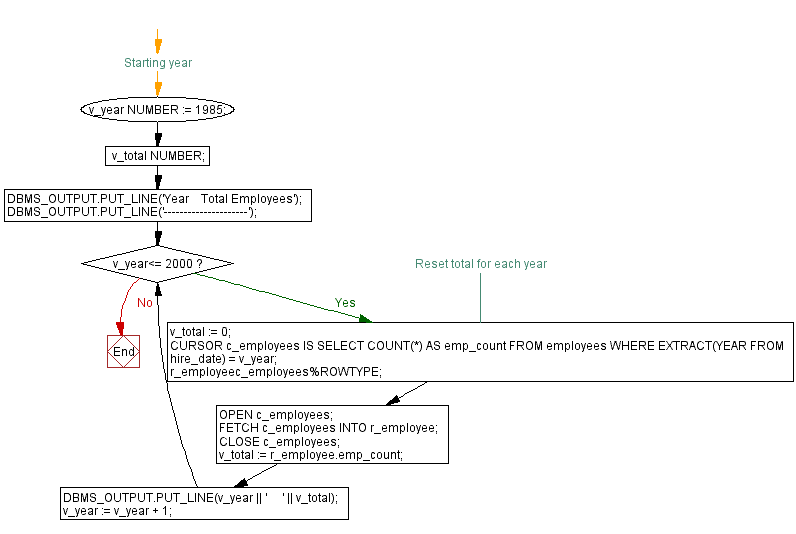PL/SQL program to display total number of employees hired each year
PL/SQL While Loop: Exercise-16 with Solution
Write a PL/SQL program to display the total number of employees hired each year between 1985 and 2000. Return the result in tabular format.
Sample Solution:
Table: employees
employee_id integer first_name varchar(25) last_name varchar(25) email archar(25) phone_number varchar(15) hire_date date job_id varchar(25) salary integer commission_pct decimal(5,2) manager_id integer department_id integer
PL/SQL Code:
DECLARE
v_year NUMBER := 1985; -- Starting year
v_total NUMBER;
BEGIN
DBMS_OUTPUT.PUT_LINE('Year Total Employees');
DBMS_OUTPUT.PUT_LINE('---------------------');
WHILE v_year<= 2000 LOOP
v_total := 0; -- Reset total for each year
DECLARE
CURSOR c_employees IS
SELECT COUNT(*) AS emp_count
FROM employees
WHERE EXTRACT(YEAR FROM hire_date) = v_year;
r_employeec_employees%ROWTYPE;
BEGIN
OPEN c_employees;
FETCH c_employees INTO r_employee;
CLOSE c_employees;
v_total := r_employee.emp_count;
END;
DBMS_OUTPUT.PUT_LINE(v_year || ' ' || v_total);
v_year := v_year + 1;
END LOOP;
END;
/
Sample Output:
Year Total Employees --------------------- 1985 0 1986 0 1987 107 1988 0 1989 0 1990 0 1991 0 1992 0 1993 0 1994 0 1995 0 1996 0 1997 0 1998 0 1999 0 2000 0
Explanation:
The said code in Oracle's PL/SQL that calculates and displays the total number of employees hired each year starting from 1985 and ending at 2000.
Within the outer loop, a variable v_total initializes to keep track of the total number of employees hired in each year.
Within the inner loop, a cursor c_employees is defined that fetches the count of employees hired in the year mentioned in the hire_date column and the result is stored in the variable v_total.
The DBMS_OUTPUT.PUT_LINE function displays the year and the corresponding number of employees hired in this year.
Flowchart:

Go to:
PREV : Count Employees in Each Department.
NEXT : Employee count by country.
Improve this sample solution and post your code through Disqus
What is the difficulty level of this exercise?
